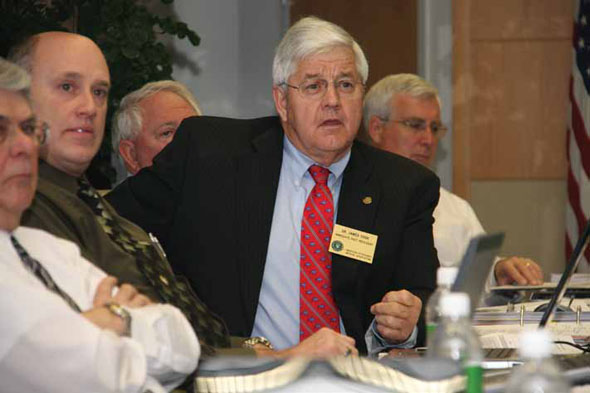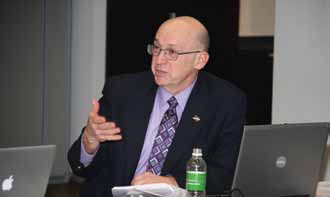AVMA renews VLE sponsorship, moves forward with diversity plan
The AVMA Executive Board, during its Nov. 19-21 meeting, dealt with proposals addressing a range of issues, including veterinary student development, diversity within the profession, and strategic alliances.
The board passed $79,125 in new spending for the previously approved 2010 budget—$75,000 from reserves and $4,125 from the contingency fund.

In addition, the board made recommendations to the AVMA House of Delegates on the five resolutions and three bylaws amendments coming before the body during its regular winter session this January in Chicago.
VLE funding
Board members voted in favor of renewing sponsorship for the AVMA Veterinary Leadership Experience with a two-year, $150,000 commitment.
Since 2005, the AVMA has funded the popular leadership development program for a total of $315,000. But the board voted this past July to suspend its sponsorship while the AVMA Membership and Field Services Division determined whether the Association could better support veterinary students through other initiatives (see JAVMA, Sept. 1, 2009).
The M&FS Division interviewed veterinary students and faculty and conducted a review of other student-aimed programs. In addition, the estimated costs to the AVMA of hosting a leadership training program comparable with the VLE came in at just a little more that $145,000 a year, according to the division.
The M&FS Division, therefore, determined that the VLE was the best use of the AVMA's money at this time and, along with AVMA CEO W. Ron DeHaven, recommended that the board fund the VLE at $75,000 annually in 2010 and 2011.
"I'm pleased that the AVMA's moving forward to continue their funding of this really important project, which many students have characterized as life-changing," said VLE co-founder and facilitator Dr. Richard M. DeBowes after the board meeting.
The VLE started at Washington State University in 2002 as a leadership development program for veterinary students. The AVMA agreed to co-sponsor the program beginning in 2005 with the stipulation that it be called the AVMA Veterinary Leadership Experience. In January 2009, the AVMA House of Delegates approved a resolution encouraging the Executive Board to support the program for four years.
Student AVMA President Rebecca Steers welcomed the board decision to re-fund the program. "The overwhelming consensus from students is that the ideals behind the AVMA VLE are important to our profession, and as such, SAVMA is delighted that the AVMA Executive Board has decided to continue funding for the next two years," Steers said.
The board's desire to support veterinary students was apparent during the deliberations but so was the recognition that this should be done in a fiscally responsible manner. Some board members favored funding the VLE for one year only or reducing the $75,000 annual allocation.
Others felt the two-year time frame provides the VLE administrators adequate time to find alternative funding sources while also providing the M&FS Division with room to explore options for providing students with leadership training.
"We need to give Member Services time to look at this more closely to figure out what's the best way ahead," said Dr. Larry G. Dee, District IV representative to the board, who in describing the VLE said, "They're not just providing a leadership experience, they're raising zealots."
Dr. Kevin J. Dajka, M&FS Division director, believes the Executive Board acted in the best interests of the profession despite the financial constraints. "It was a difficult decision," he said, "because we owe it to our members to make sure we invest in programs that are making an impact, especially in this economic climate.
"AVMA also understands it owes it to the profession to keep investing in our future. By funding the AVMA VLE, the AVMA continues to make that commitment."
Diversity plan
During the meeting, the board also approved incorporating a draft AVMA Diversity Plan into the AVMA Strategic Plan. The diversity plan, developed in 2009, extracts recommendations from the 2006 Report of the AVMA Task Force on Diversity and incorporates them as tactics under the Association's existing strategic objectives.

"What we really need to do is integrate diversity through everything we do, and tying into the strategic plan is a very good way to do that," said Barbara Baldwin, AVMA staff liaison to the former Task Force on Diversity and an assistant director of the M&FS Division.
The draft diversity plan introduces a number of tactics to increase the diversity of the profession under the AVMA's strategic goals of advocacy, animal welfare, economic viability, veterinary education, and workforce development.
Dr. Larry R. Corry, AVMA president, has made diversity a priority for his term. Dr. Larry M. Kornegay, AVMA president-elect and chair of the former Task Force on Diversity, plans to continue the focus on diversity when he succeeds Dr. Corry in July.
"It is all about having representation of a wide range of perspectives and taking these varying points of view into account to reach our goals and solve our problems," Dr. Kornegay said after the board meeting. "We are all familiar with the concept of diversity, but how many of us truly practice inclusion?"
According to the draft AVMA Diversity Plan, tactics to increase diversity and inclusivity in veterinary medicine could include supporting federal programs that foster diversity in the health professions and partnering with industry and foundations to promote the business case for diversity—that it provides the broad range of ideas and perspectives necessary to compete effectively.
Resolutions, amendments
The Executive Board added its recommendations on the resolutions and proposed amendments to the AVMA Bylaws that the AVMA House of Delegates will consider at its regular winter session Jan. 9 (see JAVMA, Dec. 15, 2009).
Resolutions 1 and 4 propose two contrasting revisions to the AVMA policy "Use of Random-Source Dogs and Cats in Research, Testing, and Education." Resolution 1 would revise AVMA policy to state that class B dealers should not be used. Class B dealers typically obtain animals from pounds and shelters, owners who wish to relinquish ownership, and other sources. Resolution 4 would revise AVMA policy to provide for use of class B dealers only when viable alternatives do not exist and calls for an exploration of alternative sources that would ultimately eliminate the need for these dealers as sources. The board recommended that the HOD disapprove Resolution 1 but approve Resolution 4.
Resolution 2, submitted by the Executive Board and the House Advisory Committee, is a proposal to increase member dues.
The board made no recommendation on Resolution 3, which would restructure the HOD reference committees to reflect the AVMA strategic goals.
Resolution 5 commits the AVMA to supporting the development of comprehensive, integrated disease surveillance of the U.S. swine herd for H1N1 and other influenza viruses, emerging and endemic diseases, and foreign animal diseases. The board recommended approval.

The board submitted Bylaws Amendment 1, which would add the Student AVMA president to the list of participants invited to participate, without a vote, in regular and special meetings of the board.
Bylaws Amendment 2 would add a provision to the section on composition of the HOD stating that—except for voting rights—delegates and alternate delegates would have equal authority and responsibility within the HOD. The board recommended disapproval.
Bylaws Amendment 3 proposed term limits for delegates and alternate delegates. The board recommended approval, although some board members viewed term lengths as a decision for each constituent organization.
To view the full texts, go to www.avma.org, click on the "About the AVMA" bar, then on "House of Delegates 2010 Winter Session Agenda Items."
NAVTA alliance
The AVMA plans to develop an alliance with the National Association of Veterinary Technicians in America.
"It really speaks to our philosophy of team health care and our commitment to partnership," said Dr. Janver D. Krehbiel, District V representative and a member of the AVMA-NAVTA Executive Board Liaison Committee, during the board meeting. "This would be an opportunity for us to recognize the technicians who work alongside us."
The board approved a draft framework outlining the structure of the alliance, which would allow NAVTA members to be NAVTA affiliate members of the AVMA. Under the draft framework, a portion of the NAVTA annual dues of $50 per member would go to the AVMA.
Cherylann Gieseke, NAVTA president, believes the alliance will be mutually beneficial to the AVMA and NAVTA, similar to the partnership between veterinarians and veterinary technicians. "Everything works better when you work the way you're supposed to—together," she said.
As part of the alliance, the AVMA would provide NAVTA affiliate members with access to many of the Association's services. The NAVTA affiliate members would be able to access the AVMA Veterinary Career Center, for example, and to subscribe to the AVMA scientific journals at reduced rates. The AVMA Group Health and Life Insurance Trust and the PLIT are planning to create specific coverage packages and services for veterinary technicians.
Under the draft agreement, NAVTA affiliate members would not be able to vote or hold office in the AVMA. The board will review a final proposal at a later date.
Center for animal welfare
The board approved exploring a partnership with the Department of Agriculture to file an application to establish a joint OIE Collaborating Center for Animal Welfare. The World Organisation for Animal Health (OIE) defines collaborating centers as centers of expertise in specific spheres relevant to animal health and welfare.
The AVMA has consistently been promoting itself and its members as experts on animal care and welfare, whereas only recently, the Animal Care unit of the USDA Animal and Plant Health Inspection Service received authorization to create a Center for Animal Welfare. The groups independently expressed interest in forming an OIE Collaborating Center for Animal Welfare and are now exploring the feasibility of a joint effort.
AVMA Web site
The board accepted as information a business plan outlining the latest stage in the Association's efforts to create a next-generation Web site. In accordance with an earlier board directive, the consulting firm Ellipsis Partners of Maryland completed a two-month review of the AVMA Web site.
The resulting business plan makes recommendations regarding the primary purposes of and audiences for the AVMA Web site as well as suggested areas of improvement. The Executive Board directed Ellipsis to proceed and return to the board with suggested vendors and cost estimates.